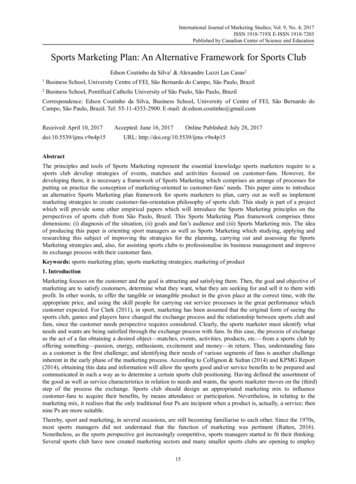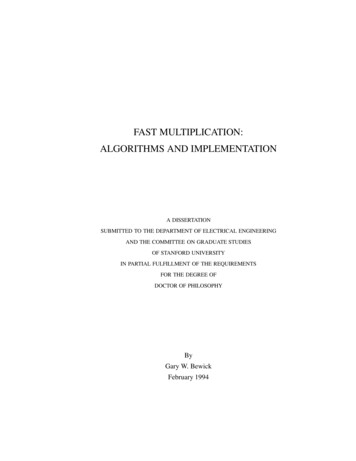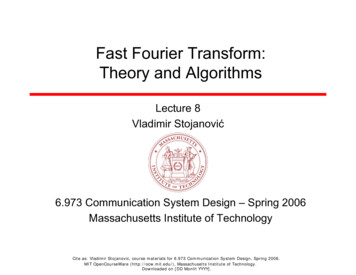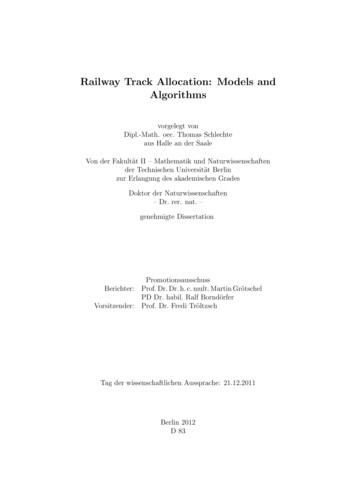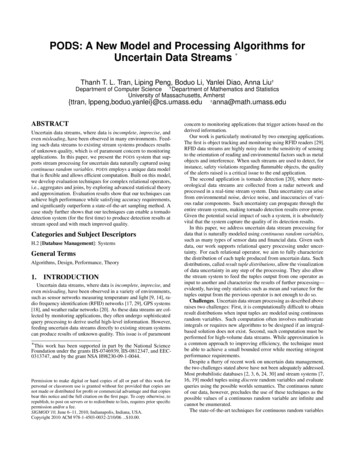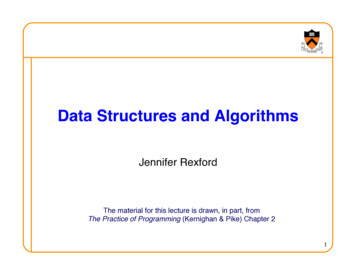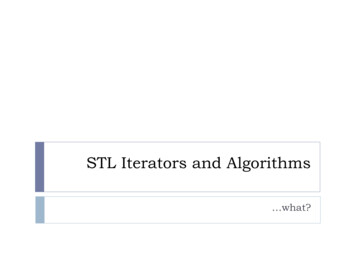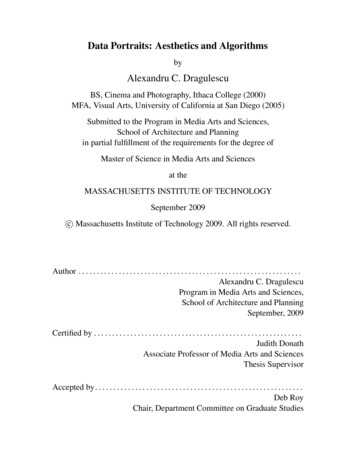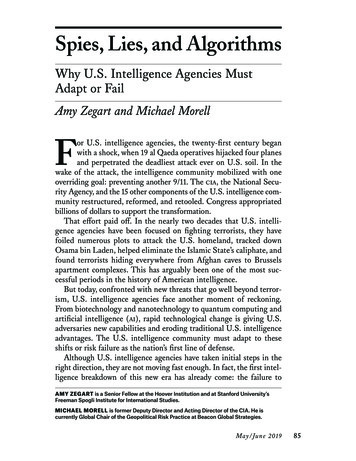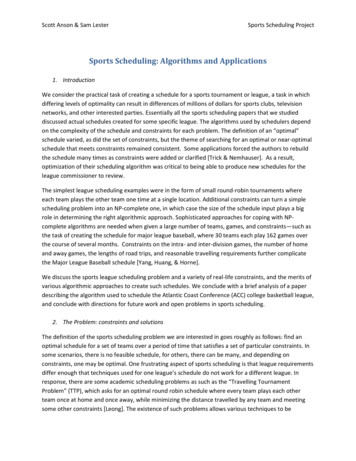
Transcription
Scott Anson & Sam LesterSports Scheduling ProjectSports Scheduling: Algorithms and Applications1. IntroductionWe consider the practical task of creating a schedule for a sports tournament or league, a task in whichdiffering levels of optimality can result in differences of millions of dollars for sports clubs, televisionnetworks, and other interested parties. Essentially all the sports scheduling papers that we studieddiscussed actual schedules created for some specific league. The algorithms used by schedulers dependon the complexity of the schedule and constraints for each problem. The definition of an “optimal”schedule varied, as did the set of constraints, but the theme of searching for an optimal or near-optimalschedule that meets constraints remained consistent. Some applications forced the authors to rebuildthe schedule many times as constraints were added or clarified [Trick & Nemhauser]. As a result,optimization of their scheduling algorithm was critical to being able to produce new schedules for theleague commissioner to review.The simplest league scheduling examples were in the form of small round-robin tournaments whereeach team plays the other team one time at a single location. Additional constraints can turn a simplescheduling problem into an NP-complete one, in which case the size of the schedule input plays a bigrole in determining the right algorithmic approach. Sophisticated approaches for coping with NPcomplete algorithms are needed when given a large number of teams, games, and constraints—such asthe task of creating the schedule for major league baseball, where 30 teams each play 162 games overthe course of several months. Constraints on the intra- and inter-division games, the number of homeand away games, the lengths of road trips, and reasonable travelling requirements further complicatethe Major League Baseball schedule [Yang, Huang, & Horne].We discuss the sports league scheduling problem and a variety of real-life constraints, and the merits ofvarious algorithmic approaches to create such schedules. We conclude with a brief analysis of a paperdescribing the algorithm used to schedule the Atlantic Coast Conference (ACC) college basketball league,and conclude with directions for future work and open problems in sports scheduling.2. The Problem: constraints and solutionsThe definition of the sports scheduling problem we are interested in goes roughly as follows: find anoptimal schedule for a set of teams over a period of time that satisfies a set of particular constraints. Insome scenarios, there is no feasible schedule, for others, there can be many, and depending onconstraints, one may be optimal. One frustrating aspect of sports scheduling is that league requirementsdiffer enough that techniques used for one league’s schedule do not work for a different league. Inresponse, there are some academic scheduling problems as such as the “Travelling TournamentProblem” (TTP), which asks for an optimal round robin schedule where every team plays each otherteam once at home and once away, while minimizing the distance travelled by any team and meetingsome other constraints [Leong]. The existence of such problems allows various techniques to be
Scott Anson & Sam LesterSports Scheduling Projectcompared, which has some use, though it does not mean the techniques that work best for the TTP willwork best for a real sports league.The amount and type of scheduling constraints often determines the difficulty of the problem.Constraints can be applied globally to the entire schedule or locally to some portion (only in June,weekends, etc.). Consider the impact of sports league scheduling constraints as given below:Venue constraints: every game is either “home” or “away”. Fairness of venue is often applied to theentire schedule and portions of the schedule, for example, correct proportion of home games onweekends, as well as in the first half of the season.Break constraints: a break is defined as consecutive home or away games (as opposed to “nobreaks”—an alternating sequence of home and away games). Finding min-break schedules has beenan active research topic, and yet a minimum break schedule is not appropriate for many schedulingapplications, such as Major League Baseball.Time and Distance constraints: fairness of game times (avoid Friday night at 9PM followed bySaturday at 12 noon) and accounting for time zone differences, such as fairness to each team withrespect to the time and cost of travelling between venues.Variety and carry-over: a good schedule has “variety”. As an example, suppose each team playsevery other team N times: intuitively, you would like to spread the N times over the course of theschedule while minimizing “carry-over”. Carry-over is easiest explained with an example: supposethat the times when A plays team C, A has always just played team B the game before. Then if B is avery strong or weak team, it could have a “carry-over” affect on A’s performance against team C.Hierarchal constraints: an example might be the division and conference structure of a league,where a team should play a certain portion of games in its own conference, and another portionwithin its own division, etc. Another example is application of time constraints in terms of permonth and per-week.Desired, fixed, or prohibited games: often relating to certain times of the season, for example,“Duke should play UNC in the last week of the season”, or “don’t match up the two conferencefootball champions in the first two weeks of the season”.Preferential constraints: constraints relating to such things as maximizing predicted televisionratings, attendance, and other special preferences.3. Algorithmic AlternativesThe variety of sports scheduling applications and constraints in turn leads to a wide range of sportsscheduling algorithms. The algorithmic alternatives that we studied and will summarize include greedyalgorithms, integer programming, constraint programming, and other approaches for hard problems.Greedy algorithms work best for simple schedules. Consider a weekend tournament where it is expectedfor each team to play each other once. By 1847, it was shown by Kirkman that a round robin scheduleexists for any 2n teams and 2n-1 time slots [Trick]. Such a schedule is typically found using either “thecircle method” or greedy algorithms:
Scott Anson & Sam LesterSports Scheduling ProjectThe circle method numbers the teams from 1.2n, and then considers the set of teams and theset of time slots. In slot i, it plays team i against team 2n (the last team), and for all A and Bother than teams i and 2n, team A plays B if index(A) index(B) 2i (mod 2n-1).The greedy method matches teams lexicographically, where team i plays team j is marked “(i,j)”,and (i,j) is scheduled before (i,k) if j k, and (i,j) is before (k,l) if i k. Games are repeatedlyassigned into current slot or next feasible slot.Both the greedy and circle methods are linear in the number of games and teams. “Simple” schedulingproblems are also sometimes solved with combinatorial approaches such as “Latin Squares” or “RoomSquares” *Dinitz . Interestingly enough, suppose we add prohibitions of the form (k,i,j) to a schedulingproblem with a greedy solution, that is, in game slot k, team i cannot play at j’s home. Now the problembecomes NP-complete! [Schaerf] Harder scheduling problems are often solved using integer orconstraint programming. A common approach seems to include first splitting the problem intosubproblems. Authors seemed to use different subproblem breakdowns, but in general, each schedulingproblem is reduced to 2-4 subproblems where each takes as input the solution sets found by thesubproblem before it, and gives all solutions that meet its constraints to the subproblem after it.The integer programming approaches that we studied split the league scheduling problem into thefollowing high-level steps:1. Use integer programming to find feasible home-away-bye patterns that meet theconstraints on number of games.2. Use integer programming to transform the “Home-Home-Away”-type patterns from step 1into a pattern that could be a team’s schedule, such as “Team 1 plays Team 2 at home,Team 3 at home, and Team 4 away”.3. Use enumerative approaches or integer programming to assign actual teams to the teamnumbers (e.g. Team 1 is the New York Yankees, etc.)Some common constraints for integer programming models included:no team can play itselfif team A plays at team B at time t, then team B plays A at home at time ta team can only play one other team at a timea team plays every other team once before it plays some team for a second timeScheduling via constraint programming is very similar to integer programming, at least from ourperspective. Constraint programs start with variables assigned to domains, and then the domains aregradually reduced by the constraints. If the domains can be reduced to singletons then a schedule hasbeen found. In a paper by Leong, the steps used for solving a Travelling Tournament Problem via aConstraint Satisfaction Problem (CSP) were almost identical to the IP approaches we had studied, theonly key difference being that the third stage was solved using a branch-and-bound technique ratherthan solving by enumeration.In a study done by Michael Trick, constraint programming was clearly better than integer programmingin terms of finding schedules with a constraint on the number of consecutive home or away games. At
Scott Anson & Sam LesterSports Scheduling Projectthe same time, when the constraint was changed to “prohibit home-away singletons”, that is, AHA orHAH sequences, it was very clear how to write the integer programming constraint and as such IP wasmuch better. The take-home point seems to be that cleverness in writing constraints can impact theeffectiveness of a solution, and poor performance of either integer or constraint programming can bedue to poorly developed constraints.The authors of the paper on the ACC basketball schedule did not win in a contest to compute the MajorLeague Baseball schedule, losing to a group of researchers who used a simulated annealing approach. Ina different publication, Trick claims that simulated annealing is difficult in scheduling problems due tolack of a natural neighborhood structure and difficulty determining what types of swaps improve thesolutions. For extremely hard scheduling problems, approaches common to coping with NP-completeproblems are used like branch-and-bound, backtracking, and evolutionary algorithms.4. A league scheduling approach for ACC BasketballWe now turn and look at the ACC Basketball scheduling problem more in detail, as described in thepaper “Scheduling a Major College Basketball Conference”, by George L. Nemhauser and Michael A.Trick published in 1997. This paper took the moderately difficult scheduling task of scheduling the 9team ACC basketball league, where each team plays the other team twice during the season (once homeand once away) with many constraints (television network requirements, travel requirements,maximized length of time between the two meetings of teams, etc). The algorithm used by Nemhauserand Trick relied heavily on integer programming and can be described at a high level as follows:1) Find feasible home-away-bye patternsA feasible pattern is one that could potentially be included in the schedule. At a minimum, it wouldinclude the appropriate number of home games, away games, and byes following the generic schedulingconstraints such as maximum consecutive home/away games, etc. Since the number of potentialpatterns determined in the first step leads directly to the increased number of solutions in each futurestep, it is very important to generate enough valid patterns such that a reasonable number of schedulescan eventually be created. However, it must be balanced with not over-generating patterns such thatwe result in too many schedules and significantly increased processing time with minimal (if any) gain.Given a small set of 9 teams, the number of potential patterns is much less than with a larger league andthus using enumeration, a reasonable number of patterns can be generated rather quickly. As thenumber of teams increase, this step would need to be reexamined for efficiency.2) Find feasible pattern setsGiven the list of all feasible patterns, select the sets of 9 patterns such that all home, away, and byegames line up for a possible schedule. These sets will be determined using integer programming basedon our list of constraints. The integer program in this case consists of 38 variables and 18 constraintsand is solved by optimizing with respect to the objective listed in the paper and then applying aconstraint, and re-optimizing until a solution is found. The result is 17 feasible pattern sets.
Scott Anson & Sam LesterSports Scheduling Project3) Find timetablesThis step assigns numbers to the home-away-bye patterns using integer programming. For example, ifwe were writing a schedule for teams A,B,C, and D, then we might have the following transformationdone in this step, where “1,2,3,4” are not yet assigned to teams A,B,C,D:1: 2, 3, @42: @1, 4, @3)4:Again, the global constraints (those that apply to all teams) must be enforced in this step so that whenwe assign teams to these patterns, the schedule is still valid. The integer program in this step issignificantly more complicated, including 234 constraints and over 300 variables. The 17 feasiblepattern sets in step 2 result in 826 feasible timetables in step 3.4) Assigning teams to patternsOnce the schedule is created, the final computational step is to assign the teams to the given patterns.In this step, individualized constraints must be taken into account. These include stadium schedulingconflicts, school finals schedules, rivalry week requirements, etc.5) Manually inspecting the overall scheduleInevitably there are constraints that are very hard to quantify and thus require vast knowledge of theleague and teams involved in order to determine if a potential schedule will work as the league intends.In the case of this paper, they supplied 3 potential schedules that met all of the constraints, yet weredeclined due to these intricacies.5. Open Problems & Possible ExtensionsGiven the exponential growth of the number of possible schedules as the number of teams, games, andconstraints increase, the computational time to enumerate these permutations also growsexponentially. Enhancements of any of the subproblems listed in Nemhauser & Trick’s paper wouldlikely improve the efficiency with which a number of league schedules could be generated. However, assoon as yesterday’s infeasible problem becomes feasible, consideration of additional schedulingconstraints as requested by referees, television, etc, can again complicate the algorithms. As analgorithm’s efficiency increases, it allows for “weighted” constraints as well as decision basedconstraints (e.g., if team A plays team B on Wed., then their next match must be on a Saturday,otherwise they can play on Friday or Sunday). As we’ve seen with many of the papers listed, the minordetails of the constraints have a major impact in the final result of the optimal schedule. Finding a wayto determine which constraints can be slightly modified for algorithmic purposes could potentially leadto much more effective solutions.Lastly, the field of sports scheduling is an interesting mix of theory and practicality, a field where nontrivial problems are NP-complete yet some solution needs to be found, optimal or not. Since theoptimality of the schedule has a lot to do with the amount of money made by the various organizationsassociated with the leagues, a theoretical advancement with practical effect could be worth millions ofdollars.
Scott Anson & Sam LesterSports Scheduling ProjectBibliography1. “Scheduling a Major College Basketball Conference”, a paper by George L. Nemhauser and MichaelA. Trick published in 1997, available online at http://mat.gsia.cmu.edu/trick/acc.pdf2. “Constraint Programming for the Travelling Tournament Problem”, a paper by Gan Tiaw Leong fromthe National University of Singapore in 2002/03, found online athttp://www.comp.nus.edu.sg/ henz/students/gan tiaw leong.pdf3. “Devising a Cost Effective Baseball Scheduling by Evolutionary Algorithms”, a paper by Jih Yang,Hsien-Da Huang, and Jorng-Tzong Horng at National Central University in Taiwan, published in 2002and available online 4491.pdf?tp &isnumber &arnumber 10044914. “Designing Schedules for Leagues and Tournaments” a paper by Jeffrey H. Dinitz of the Mathdepartment of the University of Vermont, published in 2001 (approx), available online at:http://www.emba.uvm.edu/ dinitz/preprints/design tourney talk.pdf5. Power point Sports scheduling tutorial by Michael Trick, prepared for Banff CORS/INFORMSconference of May 2004 but never presented, available online at:http://mat.tepper.cmu.edu/trick/banff.ppt
Sports Scheduling: Algorithms and Applications 1. Introduction We consider the practical task of creating a schedule for a sports tournament or league, a task in which differing levels of optimality can result in differences of millions of dollars for sports
